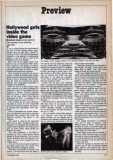TRON is a Walt Disney film that follows in the trail at other science fiction spectaculars such as Star Wars. Close Encounters Of The Third Kind and Battiestar Galactica. it has opened to considerable acclaim in the us and is due to be released in the UK in October.
Set in the not too distant future Tron starts out as a conventional thriller. Kevin Flynn. played by Jeff Bridges. is attempting to gain access to information stored in computer data banks at Encom, a multinational communications company.
Flynn is trying to prove that he wrote a number of highly successful video arcade games while he was employed by Encom. Another Encom employee. Ed Dillinger, took the credit tor inventing the games. Dillinger was subsequently promoted to company vice-president.
With the help of a fake access code. Flynn searches the Encom computer for evidence to back up his claims. But the computer's Master Control Program (MCP) is aware of Flynn's activities and cuts all his input. When Flynn tries to deprogram the MCP. it activates an experimental laser and turns it on him.
This is where the film really takes off. The laser is a form of matter transmitter which can break down objects into electrical particles and reconstitute them elsewhere.
Flynn is translated into another dimension. an electronic world where computer programs have come to life. Flynn has become. literally. the player in the machine.
This world is ruled by the tyrannical MOP and by Sark, Dillinger‘s alter ego. Programs who disagree with the MCP are captured and released in the video games grid. an arena where video games are fought to the death.
The main opposition to the MCP is provided by Tron, a video games warrior played by Bruce Boxleitner. Tron is one of the few programs who still believes in the Users, the real world programmers who created them.
Tron and Flynn are matched together in the video games grid. But. using hi-res light-cycles, they manage to escape.
With Sark and the MCP‘s minions in hot pursuit, Tron and Flynn find two allies in Yori and Bit. Bit is an electrical pulse who can only answer yes or no, depending on whether his charge is positive or negative.
Together they link up with an old priest. Dumont who plays a similar role to Obiwan Kenobi in Star Wars. Dumont gives Tron an identity disc which can store information or be used as a weapon. Thrown like a Frisbee, the disc heats up and cuts through its victim.
Armed with the disc, Tron confronts Sark in a program-to-program duel to the death. Sark loses the duel with Tron. but is revived by the MCP. But, just when it seems that Sark may be indestructible, Flynn destroys the MCP's power source.
As the MCP disintegrates, Flynn finds himself back in the real world. With access to the Encom computer, Flynn can prove his case.
Tron should be a fascinating film that will owe much of it success to the imaginative use of computer graphics. Director Stephen Lisberger. a long time fan cl video games, first had the idea for the film in 1978.
“We had played all the video games." says Lisberger. "And when we investigated computer art, we realised that by combining the concepts of electronic imaging we could bring something to life that had not been there before.
“Everyone's looking for new fantasies in the movies," he says. “Outer space has been done to death. They have gone inside the body and under the sea.
“We have created this world in Tron by taking video games and just blowing them out to the point where they are a reality. At the point where the games met computer graphics, something came alive that had not been alive before. Video games were the basis for the fantasy - computer imagery was the means to create it."
The computer graphics used in the film were largely created by two US companies. Information International Inc (Triple-I) and Mathematical Applications Group Inc (MAGI). A Artists' impressions of various objects in the film, such as the hi-res light-cycles, were plotted in three dimensions and led into a digital computer. This enabled the object's movement to be choreographed frame by frame through the film.
Each frame on the film contained two million pixels, and each pier was assigned both colour and intensity values. Thus, the 24 frames which make up one second of the film contained almost 100 million bite at information.
“For objects simulated in a computer there are no laws of physics," says Richard Taylor of Triple-I. “Each time you sit down to create a computer image you are setting completely new rules for remix. That’s what Tron is all about."
Tron is likely to give rise to a number of spin-offs. Bally Manufacturing, the largest producer of video arcade games in the US, is currently working on a Tron video game. It will be available in the UK later this year or early next year.
Given the success of sequels such as Rocky II and III and The Empire Strikes Back, there is a fair chance that Tron II will appear on the cinema screen before too long.
